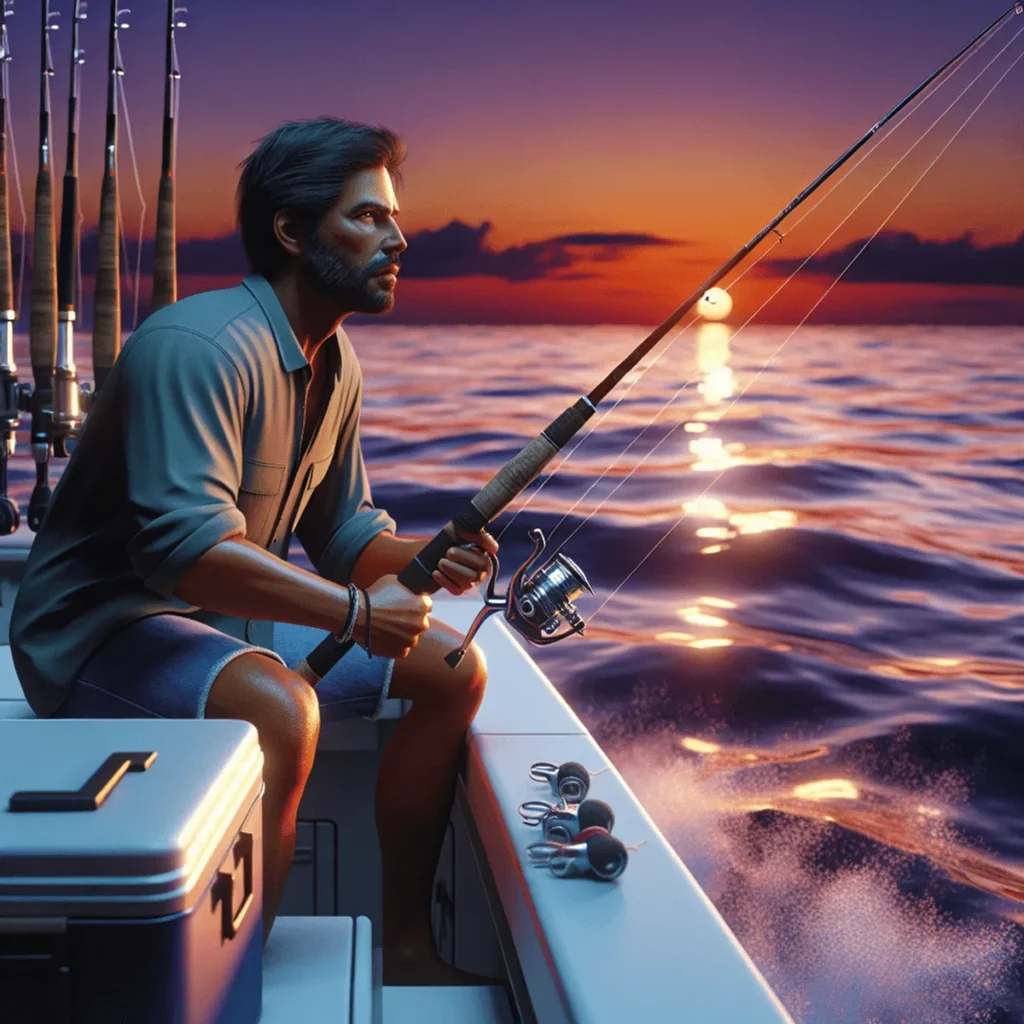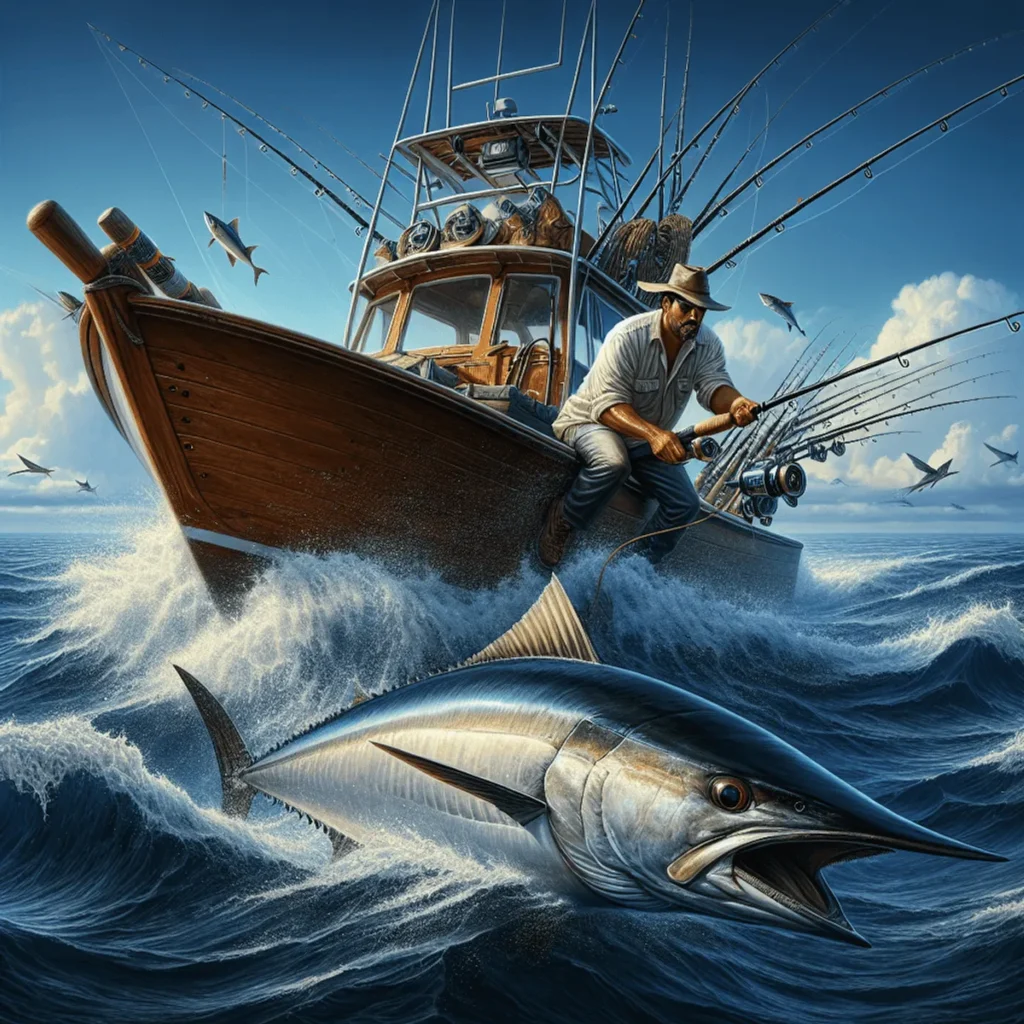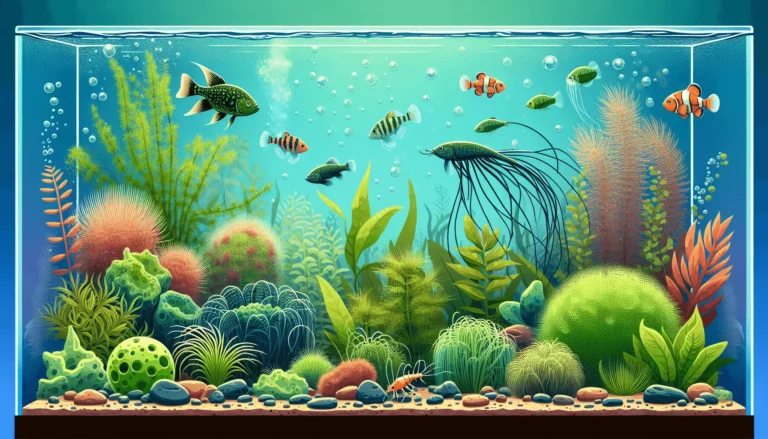Swordfishing, targeting the elusive Xiphias gladius, is one of the most exciting challenges in sportfishing. These oceanic game fish, known for their powerful runs and immense size, can grow over 9 feet long and weigh up to 1,500 pounds. The appeal lies not only in the challenge they present but also in their majestic presence in the vast oceans they inhabit.
Mastering swordfishing techniques requires:
- Knowledge of Swordfish Behavior: Understanding their feeding patterns and habitats.
- Specialized Gear: Using the right rods, reels, lines, and terminal tackle.
- Effective Fishing Strategies: Employing techniques like deep dropping and bump trolling.
- Commitment to Conservation Practices: Adhering to catch limits and promoting sustainable practices.
In this comprehensive guide, you’ll learn:
- How to identify prime swordfish habitats and their behavior patterns.
- The essential gear needed for successful swordfishing expeditions.
- Effective techniques for both daytime and nighttime fishing.
- Best bait options based on seasonal availability.
- Strategies for recognizing bites and fighting these powerful fish.
- Conservation practices to ensure the sustainability of swordfish populations.
Get ready to explore the world of swordfishing with practical tips that will improve your fishing skills while fostering a respect for these magnificent creatures.
Understanding Swordfish Behavior and Habitat
Swordfish are found in the Atlantic, Pacific, and Indian Oceans, thriving at the convergence of warm and cold waters. These regions offer a rich environment for swordfish, providing abundant prey and suitable conditions for their unique behavior.
Swordfish Habitats
- Atlantic Ocean: Swordfish primarily inhabit areas along the Gulf Stream, from the Caribbean to the Grand Banks off Newfoundland.
- Pacific Ocean: They are commonly found along the California coast, extending to Hawaii and Japan.
- Indian Ocean: Key locations include the waters around Madagascar, the Seychelles, and along the Indian subcontinent.
Feeding Patterns
Swordfish feeding behaviors vary:
- Daytime: These fish dwell at depths of 2,000 to 5,000 feet. Utilizing heavy tackle, anglers target them by deep dropping baits like squid or mackerel.
- Nighttime: At night, swordfish ascend to shallower depths (100-800 feet) following squid migrations. Anglers use light sticks to attract them during these hours.
Importance of the Deep Scattering Layer
The deep scattering layer (DSL), a zone where small marine organisms aggregate, plays a crucial role in locating swordfish. This layer moves up and down daily:
During daylight hours, it descends deeper into the ocean; at night, it rises closer to the surface.
Understanding this movement helps anglers pinpoint swordfish locations more effectively.
Essential Fishing Gear for Swordfishing

To master swordfishing, having the right fishing gear is crucial. This includes various equipment, each piece playing an essential role in the success of your fishing trip.
Necessary Fishing Equipment
When it comes to swordfish fishing gear, you need:
- Rods: Heavy-duty rods capable of withstanding the immense pressure exerted by swordfish.
- Reels: High-capacity reels, often electric, to handle the deep drops at 2,000 to 5,000 feet.
- Lines: Braided lines with high tensile strength for durability and sensitivity.
- Terminal Tackle: This includes swivels, weights, and light sticks for nighttime visibility.
Daytime vs Nighttime Gear
Daytime swordfishing requires:
- Electric Reels: To manage the depth and provide ease in reeling from extreme depths.
- Heavier Weights: Ensuring that the bait reaches the targeted depth quickly.
For nighttime fishing:
- Light Sticks: Attached near the bait to attract swordfish mimicking squid migrations.
- Lighter Tackle: As fish tend to be at shallower depths (100-800 feet). You might also want to consider using techniques similar to those employed when catching lunker bass with nightcrawlers, as they can be quite effective.
Strength and Durability
Swordfish are powerful predators. Strong hooks and durable leader materials are non-negotiable. Using robust gear minimizes the risk of losing a catch due to equipment failure. This means selecting:
- Strong Hooks: Circle hooks are effective for minimizing harm and ensuring a secure catch.
- Durable Leaders: Materials like fluorocarbon or steel leaders that can resist abrasion from a swordfish’s bill.
Equipping yourself with appropriate gear tailored for both day and night fishing increases your chances of a successful catch.
Techniques for Catching Swordfish
Daytime Swordfishing Tactics
Daytime swordfishing requires precision and patience. One effective method is deep dropping, where lines are deployed at depths ranging from 2,000 to 5,000 feet. This technique involves using heavy tackle and electric reels to manage the extreme depths.
Key steps for deep dropping:
- Select the Right Spot: Target areas with steep underwater structures or ledges where swordfish are likely to hunt.
- Deploy Heavy Weights: Use weights ranging from 10 to 15 pounds to ensure your bait reaches the desired depth.
- Monitor Your Line: Keep an eye on the line tension and depth counter to maintain the correct depth.
For those interested in exploring other deep drop techniques, such as those used for tilefish, a comprehensive guide can be found here.
Bump Trolling
Another effective daytime technique is bump trolling, which involves slowly dragging baits at various depths. This method helps cover more water and increases the chances of encountering swordfish.
Bump trolling essentials:
- Use Multiple Rods: Employ several rods at different depths to maximize coverage.
- Adjust Speed: Maintain a slow trolling speed of 1 to 3 knots.
- Change Depths Frequently: Regularly adjust the depth of your baits to find the optimal strike zone.
By mastering these daytime swordfishing tactics, you can significantly increase your chances of landing these elusive giants.
Best Baits for Swordfish
Choosing the right bait for swordfish is crucial for your success. Some popular options include:
- Squid
- Mackerel
- Bonito
Squid
Squid is a favorite among many anglers due to its natural appeal to swordfish. It can be rigged whole or in strips, often paired with light sticks to increase visibility in deep waters.
Mackerel
Mackerel offers a robust option, especially when targeting larger swordfish. Its oily scent and firm texture make it an attractive choice. Rigging mackerel typically involves threading the bait onto a strong, durable hook, ensuring it remains intact during deep drops.
Bonito
Bonito serves as another effective bait, known for its vibrant color and natural movement in water. Presenting bonito involves securing it firmly to withstand the depths and currents where swordfish dwell.
Effective Presentation Tips
Effective presentation is key to enticing strikes from these elusive predators. Ensure:
- Bait is securely attached to prevent slipping during deployment.
- Use of light sticks or glow beads during night fishing for added attraction.
- Proper alignment of bait to mimic natural swimming patterns.
Seasonal Considerations
Seasonal availability impacts bait choice. During warmer months, squid might be more abundant, while colder seasons could see a rise in mackerel and bonito populations. Adjusting your bait selections based on seasonal patterns can enhance your chances of success.
Recognizing the Bite and Fighting Strategy with Swordfish

Understanding how to recognize the bite is critical when targeting swordfish. The techniques you use, such as deep dropping or bump trolling, influence how bites are detected.
Tips for Recognizing the Bite
Deep Dropping:
When deep dropping at depths of 2,000 to 5,000 feet, swordfish bites often feel like a series of taps or a sudden heavy weight on your line. Pay attention to subtle changes in tension or movement.
Bump Trolling:
This technique involves moving the bait through the water at varying depths. Look for a rapid pull or a noticeable change in the rod’s action.
Strategies for Hook Setting and Fighting Swordfish
Once you feel the weight of a fish on your line, quick and efficient hook setting becomes essential.
Hook Setting:
Use a firm upward motion to ensure the hook penetrates. Swordfish have tough mouths; using sharp hooks can aid in better hook sets.
Managing Drag:
During intense fights, manage drag carefully to avoid breaking the line. Start with a medium drag setting and adjust as needed:
- Increase drag slowly when the fish is running away.
- Decrease drag slightly when reeling in to prevent line breakage.
Swordfish are known for their powerful runs and acrobatic jumps. Stay patient and maintain steady pressure throughout the battle to tire them out efficiently.
Conservation Practices in Swordfishing: Balancing Sport with Sustainability
Importance of Following Regulations
It’s crucial to follow catch limits and size restrictions set by fisheries management authorities to keep swordfish populations healthy. These rules are meant to stop overfishing and make sure both young and adult fish get the chance to reproduce. Seasonal closures are also important because they protect breeding populations, giving swordfish a break from fishing activities. Knowing these rules and sticking to them is key to saving the species for future generations.
Responsible Fishing Techniques
Using circle hooks is a great way to reduce harm to fish that you release. Unlike regular hooks, circle hooks are less likely to hurt the fish internally, which means they have a better chance of surviving after being caught and let go. There are also some handling techniques you can use to help with conservation:
- Don’t lift fish out of the water too much; this lowers stress and the risk of injury.
- Use tools specifically designed for removing hooks without causing more harm.
- Let fish go quickly so they spend less time away from their natural habitat.
Being sustainable in fishing means not taking too many fish. This involves understanding when a population might be struggling and choosing to catch fewer fish on your own. By doing this, you’re not only having fun but also helping make sure the sport can continue in the future.
In fact, recent reports suggest that following such sustainable practices could significantly benefit local ecosystems, as highlighted in this South Atlantic Bite update.
Finding Effective Swordfishing Spots During the Daytime
Locating productive swordfishing spots during daylight hours requires a blend of science and local expertise. Understanding ocean currents and temperature changes plays a vital role in this quest. Swordfish tend to favor areas where warm and cold waters converge, creating rich feeding grounds.
Techniques for Locating Productive Areas
1. Ocean Currents
Monitor ocean currents using tools like satellite imagery and oceanographic charts. Swordfish often congregate in upwelling zones where nutrient-rich waters rise to the surface, attracting prey. Additionally, understanding ENSO (El Niño-Southern Oscillation) patterns can provide insights into long-term ocean current changes that may affect fishing spots.
2. Temperature Changes
Pay attention to sea surface temperature (SST) data. Swordfish are known to inhabit thermoclines—layers of water with significant temperature differences—which can be identified through SST maps.
Leveraging Local Knowledge
Utilizing the expertise of local guides or resources can significantly enhance your chances:
1. Local Guides
Services like Baitmasters of South Florida specialize in targeting swordfish. They possess invaluable local knowledge about specific spots, seasonal patterns, and effective techniques.
2. Community Networks
Engage with local fishing communities or online forums. Experienced anglers often share insights on productive locations and current swordfish activity.
Employing these strategies will help you find daytime swordfishing spots more effectively, increasing your chances of a successful catch. Furthermore, staying updated with reports such as the Annual State of the Coast and Ocean Report can also provide valuable information regarding environmental conditions affecting fish populations.
Conclusion: Mastering the Art of Swordfishing Responsibly
Mastering swordfishing techniques responsibly is key to preserving the sport for future generations. As you enjoy this exciting pursuit, always practice ethical angling:
- Adhere to catch limits and size restrictions set by authorities.
- Use circle hooks to minimize harm to released fish.
- Employ proper handling techniques to ensure the survival of released swordfish.
Your commitment to these practices ensures that we can all continue to share in the thrill of catching these magnificent fish, balancing our passion with the need for sustainability.
FAQs (Frequently Asked Questions)
What is swordfishing and why is it considered an exciting sport?
Swordfishing, targeting the Xiphias gladius, is a thrilling sport that captivates anglers due to the challenge of catching this powerful pelagic game fish. It requires a deep understanding of swordfish behavior, specialized gear, effective strategies, and a commitment to conservation practices.
What are the key factors to consider when understanding swordfish behavior and habitat?
Swordfish inhabit warm and cold water convergence zones across the Atlantic, Pacific, and Indian Oceans. Their feeding patterns vary based on the time of day and season, making it essential to analyze the deep scattering layer to locate them effectively.
What essential fishing gear do I need for swordfishing?
Essential gear for swordfishing includes robust rods, reels, lines, and terminal tackle. It’s crucial to have strong hooks and durable leader materials that can withstand the power of swordfish. Additionally, gear recommendations differ for daytime versus nighttime fishing based on depth and visibility conditions.
What techniques are effective for catching swordfish during the day?
Effective daytime swordfishing techniques include deep dropping at specific depths between 2,000 to 5,000 feet and bump trolling at various depths to attract these elusive fish. Understanding these methods can significantly improve your chances of success.
Which baits are considered best for attracting swordfish?
The most effective baits for swordfishing include squid, mackerel, and bonito. Proper presentation of these baits is crucial to entice strikes from swordfish, with recommendations varying based on seasonal availability.
How can I practice responsible conservation while swordfishing?
Practicing responsible conservation in swordfishing involves adhering to catch limits and size restrictions set by fisheries management authorities. Utilizing circle hooks minimizes harm to released fish, and promoting sustainability through proper handling techniques ensures that future generations can enjoy this sport.




